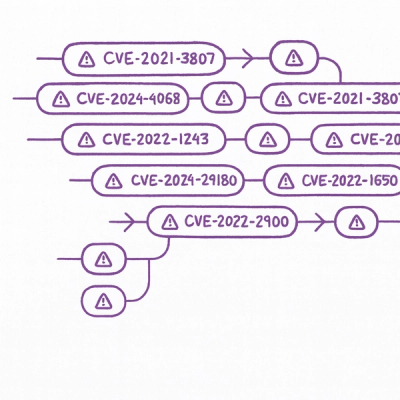
Security News
New Website “Is It Really FOSS?” Tracks Transparency in Open Source Distribution Models
A new site reviews software projects to reveal if they’re truly FOSS, making complex licensing and distribution models easy to understand.
Quickly convert math equations into beautiful SVGs (or PNGs/MathML).

SVG and especially PNG generation is currently unmaintained. This library should primarily be used for MathML generation.
Please reach out if you would like to mantain SVG and PNG portions of the library.
Add this line to your application's Gemfile:
gem 'mathematical'
And then execute:
$ bundle
Or install it yourself as:
$ gem install mathematical
Note: you'll probably need to run script/bootstrap to fetch all the necessary dependencies.
The simplest way to do this is
require 'mathematical'
Mathematical.new.render(string_with_math)
string_with_math should just be a string of TeX math. The default delimiters are $..$ for inline and $$..$$ for display. These can be changed by options--see below.
The output will be a hash, with keys that depend on the format you want:
:width: the width of the resulting image:height: the height of the resulting image:data: the actual string of SVG:width: the width of the resulting image:height: the height of the resulting image:data: the PNG data:data: the MathML data:data: the original invalid TeX:exception: the error class (with message)Note: If you pass in invalid TeX, an error is not raised, but a message is printed to STDERR. It is the caller's responsibility to check for :exception and act on it.
render just converts a single equation. There are several other methods you can use:
filter: Given a string with a mix of TeX math and non-math elements, this returns a single string containing just the converted math elements.text_filter: Given a string with a mix of TeX math and non-math elements, this converts all the math and leaves the rest of the string unmodified.strict_filter: Given a string with a mix of TeX math and non-math elements, this converts all the math and leaves the rest of the string unmodified. HTML tags are removed completely.Rather than just a string, you can also provide an array of math inputs:
inputs = []
inputs << '$\pi$'
inputs << '$not__thisisnotreal$'
inputs << '$\alpha$'
Mathematical.new.render(inputs)
This returns an array of hashes, rendering the indices. For example, for the above, you will receive the following output:
[ {:data => "...", :width => ... }, { :data => '$not__thisisnotreal$', :exception => "...", {:data => "...", :width => ... }]
That is, while the first and last elements are valid TeX math, the middle one is not, so the same string is returned. As with single strings, the error message is printed to STDERR, but not raised.
Mathematical.new takes an optional hash to define a few options:
| Name | Description | Default |
|---|---|---|
:ppi | A double determining the pixels per inch of the resulting SVG | 72.0 |
:zoom | A double determining the zoom level of the resulting SVG | 1.0 |
:base64 | A boolean determining whether Mathematical's output should be a base64-encoded SVG string | false |
:maxsize | A numeral indicating the MAXSIZE the output string can be. | unsigned long |
:format | A symbol indicating whether you want an :svg, :png, or :mathml output. | :svg |
:delimiter | A symbol indicating whether you want an :DOLLAR for inline ($..$), :DOUBLE for display ($$..$$), :PARENS for inline (\(..\)), :BRACKETS for display ([..\]), or :ENVIRONMENTS for parsing bare \\begin..\\end environments. You can also pass in an array of symbols to have multiple delimiters considered. | [:DOLLAR, :DOUBLE] |
Pass these in like this:
options = { :ppi => 200.0, :zoom => 5.0, :base64 => true }
renderer = Mathematical.new(options)
renderer.render('$a \ne b$')
Check out SUPPORTED.md on the mtex2MML website.
Note: This library makes a few assumptions about the strings that you pass in. It assumes that $..$ is inline math and $$..$$ is display math.
Before building this gem, you must install the following libraries:
*-dev version is also required)After cloning the repo, you can fetch dependencies and run the library by typing:
script/bootstrap
bundle exec rake compile
If there were no errors, you're done! Otherwise, make sure to follow the dependency instructions.
Install the fonts with:
cd ~/Library/Fonts
curl -LO http://mirrors.ctan.org/fonts/cm/ps-type1/bakoma/ttf/cmex10.ttf \
-LO http://mirrors.ctan.org/fonts/cm/ps-type1/bakoma/ttf/cmmi10.ttf \
-LO http://mirrors.ctan.org/fonts/cm/ps-type1/bakoma/ttf/cmr10.ttf \
-LO http://mirrors.ctan.org/fonts/cm/ps-type1/bakoma/ttf/cmsy10.ttf \
-LO http://mirrors.ctan.org/fonts/cm/ps-type1/bakoma/ttf/esint10.ttf \
-LO http://mirrors.ctan.org/fonts/cm/ps-type1/bakoma/ttf/eufm10.ttf \
-LO http://mirrors.ctan.org/fonts/cm/ps-type1/bakoma/ttf/msam10.ttf \
-LO http://mirrors.ctan.org/fonts/cm/ps-type1/bakoma/ttf/msbm10.ttf
If you're having issues building Lasem, or have Lasem already preinstalled, you should set the MATHEMATICAL_USE_SYSTEM_LASEM environment variable to skip the build:
If you use bundler:
MATHEMATICAL_USE_SYSTEM_LASEM=1 bundle install
If you use gem install:
MATHEMATICAL_USE_SYSTEM_LASEM=1 gem install mathematical
If you're having issues building mtex2mml, or have mtex2mml already preinstalled, you should set the MATHEMATICAL_USE_SYSTEM_MTEX2MML environment variable to skip the build:
If you use bundler:
MATHEMATICAL_USE_SYSTEM_MTEX2MML=1 bundle install
If you use gem install:
MATHEMATICAL_USE_SYSTEM_MTEX2MML=1 gem install mathematical
Run benchmarks with bundle exec rake benchmark:
Benchmarking....
Count: 3868 equations
Iterations: 1
user system total real
Rendering... 3.280000 0.070000 3.350000 ( 4.324458)
There are a smattering of libraries written in various languages to convert math into a variety of formats. But there needs to be a sane way to show math equations in the browser. With browser support for MathML under attack, it's unfortunately not a sustainable solution. A PNG or SVG representation of the equation is the safest way to go.
Most advice suggests using MathJax. While extremely popular I dislike the "stuttering" effect caused by pages loading math. JavaScript shouldn't be used in situations where server-rendering is a possibility, in my opinion.
To that end, I obsessed over the problem of server-side math rendering for over a week. Here was my journey:
I started out with blahtexml, which takes
TeX equations and converts them to PNG. This wasn't a bad idea, but it took too long;
for twelve equations, it took eight seconds. It was slow because it shelled out
to LaTeX, then dvipng.
In fact, as I discovered, most projects on the 'Net shell out to LaTeX, then
something else, which makes performance absolutely horrid. I had to find something
better, with preferably no dependency on LaTeX.
mimetex was my next attempt. It looked
great: a pure C implementation that turned TeX equations into a rasterized representation,
and then into a PNG. The speed was there, but the output image was pretty jagged.
I tweaked the program to output BMPs, and tried to sharpen those with potrace,
but the results were less then pleasant. The "update" to mimetex is mathtex,
but it, too, depends on LaTeX and dvipng binaries to produce images.
pmml2svg had potential. It's a set of
XSLT stylesheets to convert MathML to SVG. Unfortunately, it relies on XSLT 2.0,
of which there are no Ruby bindings (at the time of this writing, April '14). It
had to rely on Saxon and Java.
tth converts TeX to HTML, but the
output is aesthetically unpleasing, so I passed.
Wikipedia uses texvc, which is written in OCaml,
a language I am utterly unfamiliar with. In any event, I could not get the code
to compile on my machine.
It took me forever to finally compile gtkmathview,
and when it did, I got a bunch of SVG images with screwed up fonts.
dvisvgm worked well, but still depended
on two external binaries (LaTeX to convert the text to dvi, and dvisvgm to turn
it into SVG)
At one point, I began to try and convert the MathJax code to Ruby to figure out
how it accomplished its toSVG methods. The MathJax codebase, while written by
geniuses, is incomprehensible, due in part to JavaScript's inability
to possess a coherent structure.
Near the end of my wits, I mimicked the behavior of mathrender2,
which uses PhantomJS to embed MathJax onto a fake
HTML page. This produced exactly what I needed: a bunch of accurate SVG files with
no intermediate binaries. It was, unfortunately, a bit slow: for an arbitrary
composition of 880 equations, it took about eight seconds to complete. Could I
do better?
I came across Lasem, which met every need. It has no external binary dependencies (only library packages), can convert directly to SVG, and it's fast. The same arbitrary 880 equations were rendered in moments.
And thus a wrapper was born.
Check out math-to-itex, which quickly parses out TeX notation from strings.
With it, you could do something fun like:
MathToItex(string).convert do |eq, type|
svg_content = Mathematical.new(:base64 => true).render(eq)
# create image tags of math with base64-encoded SVGs
%|<img class="#{type.to_s}-math" data-math-type="#{type.to_s}-math" src="#{svg_content}"/>|
end
FAQs
Unknown package
We found that mathematical demonstrated a not healthy version release cadence and project activity because the last version was released a year ago. It has 1 open source maintainer collaborating on the project.
Did you know?

Socket for GitHub automatically highlights issues in each pull request and monitors the health of all your open source dependencies. Discover the contents of your packages and block harmful activity before you install or update your dependencies.

Security News
A new site reviews software projects to reveal if they’re truly FOSS, making complex licensing and distribution models easy to understand.

Security News
Astral unveils pyx, a Python-native package registry in beta, designed to speed installs, enhance security, and integrate deeply with uv.

Security News
The Latio podcast explores how static and runtime reachability help teams prioritize exploitable vulnerabilities and streamline AppSec workflows.